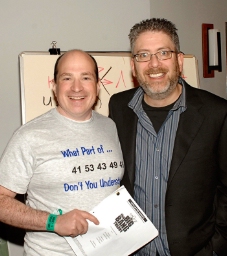A little while back, I made a sojourn to Los Angeles to get a few things done. You know, the usual for a science blogger: get a tattoo, hang out with a man crush, watch a live taping of a smash hit comedy show, meet and greet with TV execs.
Ho hum.
But one very cool thing that happened was that while watching the taping of one of my favorite shows, “The Big Bang Theory”, I met David Saltzberg. David’s a physicist and astronomer who has serious bona fides in science. All that is very cool and all, but most importantly as far as I’m concerned is that he is the official science consultant on BBT. This is basically my dream job, so I’m very jealous.
 But not bitter, because David’s a great guy. We met up on the set and immediately started chatting and having fun. And to cement himself in my pantheon of Very Cool People, he gave me his copy of the script so I could follow along with the show. Whoa! [Bill Prady, the co-Executive Producer of the show, also gave me a copy of the script for my daughter; Bill and David are the ones in the picture, courtesy CBS, from a UCLA article interviewing David.]
But not bitter, because David’s a great guy. We met up on the set and immediately started chatting and having fun. And to cement himself in my pantheon of Very Cool People, he gave me his copy of the script so I could follow along with the show. Whoa! [Bill Prady, the co-Executive Producer of the show, also gave me a copy of the script for my daughter; Bill and David are the ones in the picture, courtesy CBS, from a UCLA article interviewing David.]
When you watch the show, take a look at the whiteboards littering the character’s apartments and offices. They always show a barrage of equations, notes, and diagrams. Those are all real! Yup, David’s work. When Sheldon and Raj argue over dark matter detection, or Leonard spouts off a line about physics, the core science is from David’s brain.
In a very wise and fun move, David has started a blog tying the science in the episodes to what’s currently known in the field, using BBT as a springboard to explain real cutting-edge stuff. It’s called The Big Blog Theory (also available en Español), and is a great read. if you’re a fan of the show, and a total science nerd (and as I always point out, if you read my blog then congrats! You’re a nerd) then you should put Big Blog Theory on your must read list. It adds a dimension to the show that otherwise wouldn’t be accessible except through ten-dimensional matrix transformations of the standard general relativistic metric, and while those are trivial to do it’s a step you now don’t need to take.